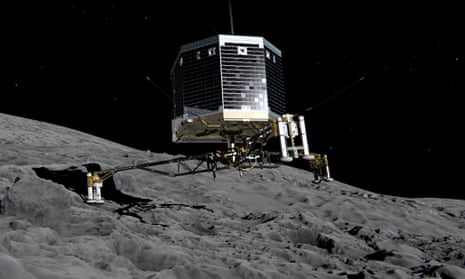Europe’s lost comet probe, Philae, is posing major problems for space engineers who are striving to pinpoint the little craft after it disappeared from view during its troubled landing on comet 67P/Churyumov-Gerasimenko in November.
Proposed manoeuvres to allow its mothership, Rosetta, to uncover its exact location have caused alarm among some scientists, who fear changes in Rosetta’s flightpath could disrupt planned observations of the comet later this year. Comet 67P is set to make its closest approach to the Sun in August and scientists want Rosetta to be perfectly placed to monitor the geysers of dust and water vapour that will pour from its surface.
“We never expected that we would lose Philae and would end up having to look for it,” Rosetta mission manager Fred Jansen told the Observer last week. “However, finding its location is a real priority – and a real headache.”
The exact location of Philae needs to be known to interpret data from its instruments – in particular, signals from its Consert (Comet Nucleus Sounding Experiment by Radiowave Transmission) device. These were emitted by Philae when it landed, passed through the comet and were picked up by Rosetta, which was then positioned on the opposite side of 67P. “That data – from Philae’s Consert instrument – is essentially an X-ray of the comet, and that makes it very valuable,” said Jansen. “It gives a clear idea of the nature of its structure. But we need to know exactly where Philae was sitting when it sent out those signals, so that we know how to interpret the information – and so far that bit of information has eluded us.”
Rosetta reached comet 67P in August last year after a 10-year journey across the solar system and revealed a twin-lobed object filled with craters, hills and cliffs. Rosetta then released Philae on 12 November. The little landing craft was supposed to employ thrusters and harpoons to attach itself to the comet’s surface. But these failed and Philae bounced several times across comet 67P before eventually settling – at an angle of about 30 degrees – in rough terrain in the shadow of a cliff or crater wall.
Its radio continued to transmit data, which revealed that the comet had a surface of hard ice and was covered by a thick layer of dust in which organic chemicals could be detected. Its Consert instruments also provided crucial data about the comet’s internal structure. However, the lander could not use its solar panels to recharge its batteries because it was stuck in shadow.
On 15 November it ceased transmission, and despite every effort European Space Agency engineers have failed to pinpoint its exact resting place, though they have narrowed it down to a 300-metre-long, 30-metre-wide strip.
“The trouble is that we need to get that down to an accuracy of about 10 metres by 10 metres to fully interpret what the Consert data is telling us,” added Jansen. “To get that accuracy, we need to photograph it from space. So far we have seen nothing, however.”
Last month engineers proposed a flight plan change that would have sent Rosetta sweeping low over the region where Philae is believed to be resting – but at the last minute vetoed the move on the grounds that it would have meant scrapping a different flyby that would have provided the craft with a shadow-free pass over the comet. This would have revealed fine details of surface structures and so was given priority.
“It takes a great deal of planning and calculation to make these different approach flights,” added Jansen. “Basically we are not going to get a chance to make a new, dedicated approach to find Philae until after 13 August when the comet will make its closest approach to the Sun.”
There is a hope, however, that Philae – having survived the low temperatures in its new residence – might receive enough sunlight to charge up its batteries as the comet gets closer and closer to the sun. Some engineers think this could happen by May or June and that the lander could summon up enough power to use its transmitter and re-establish a communications link with Rosetta.
Phliae will need about 17 watts to wake up and say hello. “If it manages that then we will be able to pinpoint without a problem,” added Jansen. “At present, there is no way of knowing if it will wake up, however.”

Comments (…)
Sign in or create your Guardian account to join the discussion